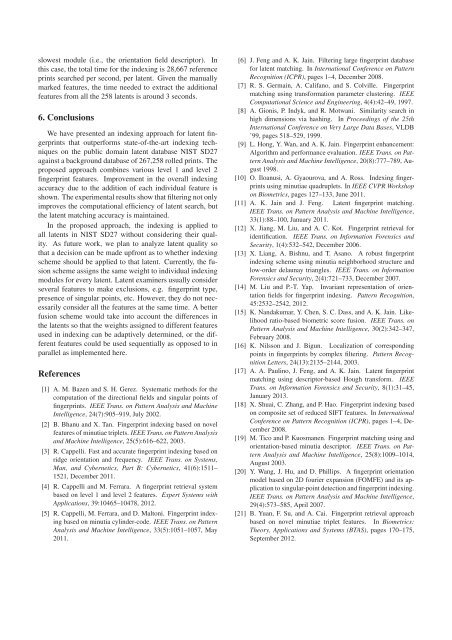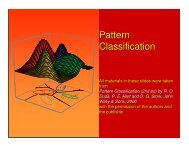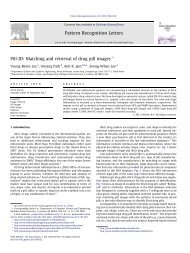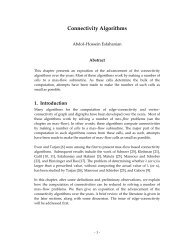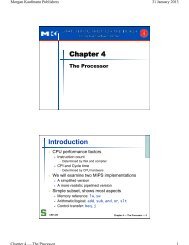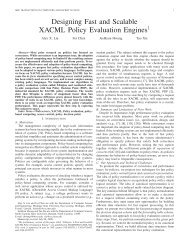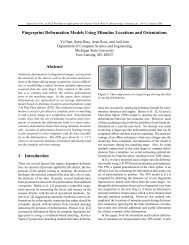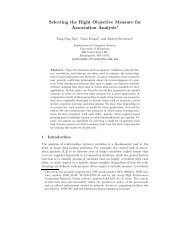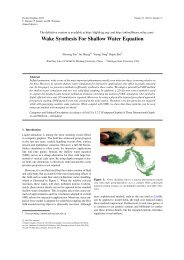Latent Fingerprint Indexing - Computer Science and Engineering
Latent Fingerprint Indexing - Computer Science and Engineering
Latent Fingerprint Indexing - Computer Science and Engineering
Create successful ePaper yourself
Turn your PDF publications into a flip-book with our unique Google optimized e-Paper software.
slowest module (i.e., the orientation field descriptor). Inthis case, the total time for the indexing is 28,667 referenceprints searched per second, per latent. Given the manuallymarked features, the time needed to extract the additionalfeatures from all the 258 latents is around 3 seconds.6. ConclusionsWe have presented an indexing approach for latent fingerprintsthat outperforms state-of-the-art indexing techniqueson the public domain latent database NIST SD27against a background database of 267,258 rolled prints. Theproposed approach combines various level 1 <strong>and</strong> level 2fingerprint features. Improvement in the overall indexingaccuracy due to the addition of each individual feature isshown. The experimental results show that filtering not onlyimproves the computational efficiency of latent search, butthe latent matching accuracy is maintained.In the proposed approach, the indexing is applied toall latents in NIST SD27 without considering their quality.As future work, we plan to analyze latent quality sothat a decision can be made upfront as to whether indexingscheme should be applied to that latent. Currently, the fusionscheme assigns the same weight to individual indexingmodules for every latent. <strong>Latent</strong> examiners usually considerseveral features to make exclusions, e.g. fingerprint type,presence of singular points, etc. However, they do not necessarilyconsider all the features at the same time. A betterfusion scheme would take into account the differences inthe latents so that the weights assigned to different featuresused in indexing can be adaptively determined, or the differentfeatures could be used sequentially as opposed to inparallel as implemented here.References[1] A. M. Bazen <strong>and</strong> S. H. Gerez. Systematic methods for thecomputation of the directional fields <strong>and</strong> singular points offingerprints. IEEE Trans. on Pattern Analysis <strong>and</strong> MachineIntelligence, 24(7):905–919, July 2002.[2] B. Bhanu <strong>and</strong> X. Tan. <strong>Fingerprint</strong> indexing based on novelfeatures of minutiae triplets. IEEE Trans. on Pattern Analysis<strong>and</strong> Machine Intelligence, 25(5):616–622, 2003.[3] R. Cappelli. Fast <strong>and</strong> accurate fingerprint indexing based onridge orientation <strong>and</strong> frequency. IEEE Trans. on Systems,Man, <strong>and</strong> Cybernetics, Part B: Cybernetics, 41(6):1511–1521, December 2011.[4] R. Cappelli <strong>and</strong> M. Ferrara. A fingerprint retrieval systembased on level 1 <strong>and</strong> level 2 features. Expert Systems withApplications, 39:10465–10478, 2012.[5] R. Cappelli, M. Ferrara, <strong>and</strong> D. Maltoni. <strong>Fingerprint</strong> indexingbased on minutia cylinder-code. IEEE Trans. on PatternAnalysis <strong>and</strong> Machine Intelligence, 33(5):1051–1057, May2011.[6] J. Feng <strong>and</strong> A. K. Jain. Filtering large fingerprint databasefor latent matching. In International Conference on PatternRecognition (ICPR), pages 1–4, December 2008.[7] R. S. Germain, A. Califano, <strong>and</strong> S. Colville. <strong>Fingerprint</strong>matching using transformation parameter clustering. IEEEComputational <strong>Science</strong> <strong>and</strong> <strong>Engineering</strong>, 4(4):42–49, 1997.[8] A. Gionis, P. Indyk, <strong>and</strong> R. Motwani. Similarity search inhigh dimensions via hashing. In Proceedings of the 25thInternational Conference on Very Large Data Bases, VLDB’99, pages 518–529, 1999.[9] L. Hong, Y. Wan, <strong>and</strong> A. K. Jain. <strong>Fingerprint</strong> enhancement:Algorithm <strong>and</strong> performance evaluation. IEEE Trans. on PatternAnalysis <strong>and</strong> Machine Intelligence, 20(8):777–789, August1998.[10] O. Iloanusi, A. Gyaourova, <strong>and</strong> A. Ross. <strong>Indexing</strong> fingerprintsusing minutiae quadruplets. In IEEE CVPR Workshopon Biometrics, pages 127–133, June 2011.[11] A. K. Jain <strong>and</strong> J. Feng. <strong>Latent</strong> fingerprint matching.IEEE Trans. on Pattern Analysis <strong>and</strong> Machine Intelligence,33(1):88–100, January 2011.[12] X. Jiang, M. Liu, <strong>and</strong> A. C. Kot. <strong>Fingerprint</strong> retrieval foridentification. IEEE Trans. on Information Forensics <strong>and</strong>Security, 1(4):532–542, December 2006.[13] X. Liang, A. Bishnu, <strong>and</strong> T. Asano. A robust fingerprintindexing scheme using minutia neighborhood structure <strong>and</strong>low-order delaunay triangles. IEEE Trans. on InformationForensics <strong>and</strong> Security, 2(4):721–733, December 2007.[14] M. Liu <strong>and</strong> P.-T. Yap. Invariant representation of orientationfields for fingerprint indexing. Pattern Recognition,45:2532–2542, 2012.[15] K. N<strong>and</strong>akumar, Y. Chen, S. C. Dass, <strong>and</strong> A. K. Jain. Likelihoodratio-based biometric score fusion. IEEE Trans. onPattern Analysis <strong>and</strong> Machine Intelligence, 30(2):342–347,February 2008.[16] K. Nilsson <strong>and</strong> J. Bigun. Localization of correspondingpoints in fingerprints by complex filtering. Pattern RecognitionLetters, 24(13):2135–2144, 2003.[17] A. A. Paulino, J. Feng, <strong>and</strong> A. K. Jain. <strong>Latent</strong> fingerprintmatching using descriptor-based Hough transform. IEEETrans. on Information Forensics <strong>and</strong> Security, 8(1):31–45,January 2013.[18] X. Shuai, C. Zhang, <strong>and</strong> P. Hao. <strong>Fingerprint</strong> indexing basedon composite set of reduced SIFT features. In InternationalConference on Pattern Recognition (ICPR), pages 1–4, December2008.[19] M. Tico <strong>and</strong> P. Kuosmanen. <strong>Fingerprint</strong> matching using <strong>and</strong>orientation-based minutia descriptor. IEEE Trans. on PatternAnalysis <strong>and</strong> Machine Intelligence, 25(8):1009–1014,August 2003.[20] Y. Wang, J. Hu, <strong>and</strong> D. Phillips. A fingerprint orientationmodel based on 2D fourier expansion (FOMFE) <strong>and</strong> its applicationto singular-point detection <strong>and</strong> fingerprint indexing.IEEE Trans. on Pattern Analysis <strong>and</strong> Machine Intelligence,29(4):573–585, April 2007.[21] B. Yuan, F. Su, <strong>and</strong> A. Cai. <strong>Fingerprint</strong> retrieval approachbased on novel minutiae triplet features. In Biometrics:Theory, Applications <strong>and</strong> Systems (BTAS), pages 170–175,September 2012.


